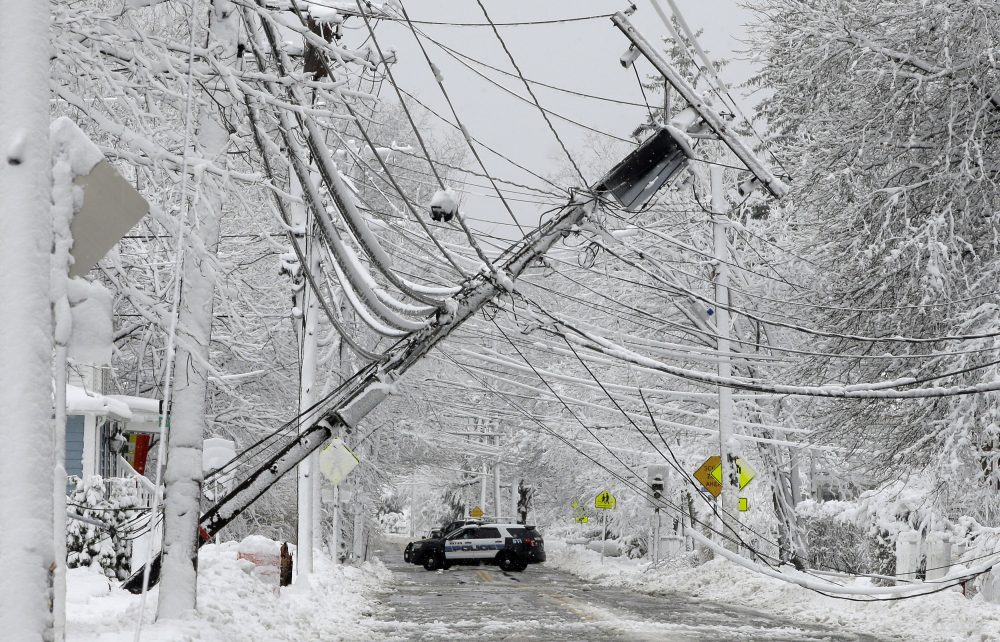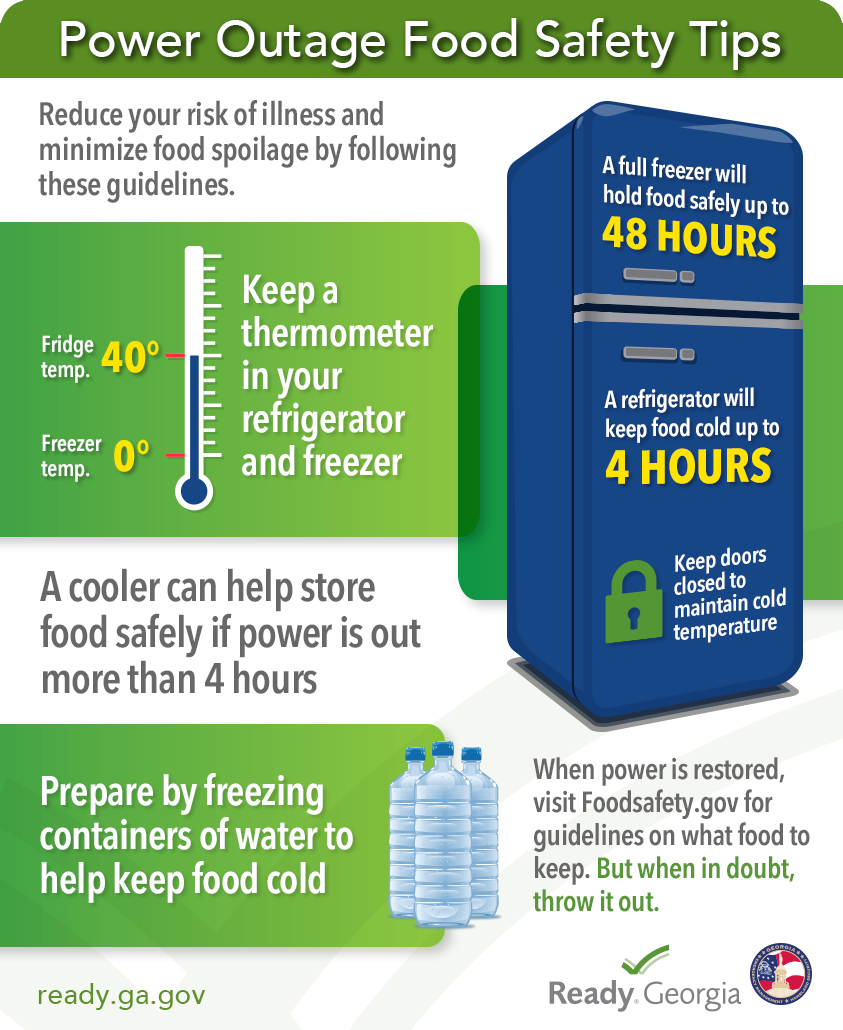Winter storms can cause power loss and are a threat to the electrical grid when snow and ice build up on power lines when the added weight causes wires and poles to break. Likewise, tree limbs also become heavy with snow and ice causing them to break and fall into power lines.
When your home loses power, one of your first concerns should be any perishable food on hand. A power outage is not only a nuisance, but can make some foods in the freezer and refrigerator unsafe to eat.



Food can only last for just a few hours when the power goes out. Knowing how to keep food safe before a loss of power – and to determine if food is safe after a loss of power – will help minimize the loss of food and reduce the risk of foodborne illness.
- Learn about proper hygiene, cross contamination, cold and hot food safety, foodborne pathogens, and best practices to prevent foodborne illness.
- Food Manager Training & ANSI Certification - $99.00
- Food Handler Training - only $7.00!
- HACCP Training: 16hr/4hr/1hr
- Food Allergy Training - $15.00
- Enter Promo "train10off" at Checkout
Food Safety for Power Outages – Actions Before/During/After
Making plans now for a potential power outage can make riding out a prolonged power outage safer, more comfortable, and prevent food illness.
There are many things you can do to minimize the impact on your health before a power outage emergency strikes. Put together an emergency survival kit with food and water preparations. Do it now and make sure you include the following items to last at least three days:
- Non-Refrigerated Items. Be prepared for an emergency by having items on hand that don't require refrigeration and can be eaten cold or heated on the outdoor grill. Shelf-stable food, boxed or canned milk, water, and canned goods should be part of a planned emergency food supply. Make sure you have ready-to-use baby formula for infants and pet food. Remember to use these items and replace them from time to time. Be sure to keep a hand-held can opener for an emergency.
- Portable gas cooker or barbeque.
- Coolers. Consider what you can do ahead of time to store your food safely in an emergency. Inexpensive styrofoam coolers can do an excellent job. Coolers are a great help for keeping food cold if the power will be out for more than 4 hours—have a couple on hand along with frozen gel packs.
- Food thermometer. A food thermometer will be necessary so you can quickly check the internal temperatures of food.
- Eating equipment – utensils, knives, pots, cups, plates, bowls, matches, lighters
- Bottled water. 3 pints per person per day, or 6 to 8 large plastic soft-drink bottles of water per person per day. 1 pint for washing food and cooking each meal, washing dishes and washing yourself.
- Keep up-to-date. Check and renew food and water every year, taking into account medical or dietary conditions in your family. If you have babies or children, make sure they have enough suitable food.
Basic of Keeping Food Safe During a Power Outage
Always keep meat, poultry, fish, and eggs refrigerated at or below 40 °F and frozen food at or below 0 °F. This may be difficult when the power is out. Refrigerator/Freezer
- Keep the refrigerator and freezer doors closed as much as possible. A refrigerator will keep food cold for about four hours if the door is kept closed. A full freezer will hold its temperature for about 48 hours (24 hours if half-full). Instead, eat shelf-stable foods.
- Place meat and poultry to one side of the freezer or on a tray to prevent cross contamination of thawing juices.
- Use dry or block ice to keep the refrigerator as cold as possible during an extended power outage. Fifty pounds of dry ice should keep a fully-stocked 18-cubic-feet freezer cold for two days.
- Do not heat your home with a gas range or oven. Using a gas range or oven for heating can cause a buildup of carbon monoxide inside your home, increasing the risk of carbon monoxide poisoning.
- Longer Outages. If it looks like the power outage will be prolonged beyond a day or so, prepare another cooler with ice for the items in your freeze. Obtain dry or block ice to keep your refrigerator as cold as possible if the power is going to be out for a prolonged period of time. Fifty pounds of dry ice should hold an 18-cubic foot full freezer for 2 days. Plan ahead and know where dry ice and block ice can be purchased.
- Have more than one cooler. Inexpensive styrofoam coolers can also do an excellent job.
- Shelf-stable foods, such as canned goods and powdered or boxed milk. These can be eaten cold or heated on a propane cooker.
- A food thermometer. With a thermometer, you can quickly check the internal temperatures of food for safe cooking.
- Sanitation is very important during and after a disaster. Effective sanitation can be obtained by adding 1 ounce of chlorine to each gallon of safe potable cool water. Wash dishes and utensils with soap and water first, rinse with clean water and sanitize with the bleach water.
- Keep utensils in safe place. Food dishes and utensils should be guarded against chemical exposure or contamination. Do not forget to store clean utensils in a clean place after washing, to be protected from re-contamination.
- Single service items. Paper plates and cups, plastic knives and forks that are used only once are highly recommended to reduce the possibility of food borne illness.
Frequently Asked Questions - After a Power Outage: Use the following Q and A's as guidance to assist in a clean up after a disaster:
FDA Video: Food Safety During Power Outages
Food Storage When Power Comes Back On – What Should I Do?
IMPORTANT: NEVER taste food to determine its safety.
Freezer Section/Foods
When the freezer is operating again, use these guidelines to decide what to do with foods that were stored in the freezer:
- If ice crystals are still visible and/or the food feels as cold as if refrigerated (40° F or below), it is safe to refreeze.
- Raw meats and poultry, cheese, juices, breads and pastries can be refrozen without losing a lot of quality.
- Prepared foods, fish, vegetables and fruits can be refrozen safely, but quality may suffer. Mark these to be used as soon as possible. Remember that seafood will be among the first to thaw and will need attention first. Also, ground meat is likely to spoil before other meats.
- If the food thawed and has not been above 40o F for more than 2 hours, cook and serve or refreeze.
- If the food thawed or was held above 40o F for more than 2 hours, generally it should be discarded because bacteria may multiply to unsafe levels under these conditions. The only foods that can be refrozen under these conditions are well-wrapped hard cheeses, butter and margarine, breads and pastries without custard fillings, fruits and fruit juices that look and smell acceptable.
- Vegetables held above 40o F for less than 6 hours may be refrozen with quality loss.
- Pecans and other nuts may be refrozen safely but may suffer quality loss.
Refrigerator Section/Foods
When the refrigerator is operating again, use these guidelines to decide what to do with foods that were stored in the refrigerator:
- Throw away leftovers and perishable foods that have been held above 40o F for more than 2 hours, including meats, poultry, fish, seafood, lunch meats, hot dogs, milk, cream, sour cream, yogurt, cream cheese, cottage cheese, soft cheeses, soy milk and eggs.
- Hard cheese and processed cheese will be okay.
- Well-wrapped butter and margarine can usually be kept as long as they do not melt; discard if rancid odors develop.
- Condiments such as ketchup, mustard, mayonnaise, pickles, relishes, piquant sauce, oil and vinegar-based salad dressings, Worcestershire sauce and steak sauces should be fine. The acid in them is a natural preservative. Jams, jellies, preserves and syrups are all right, too, because sugar is a preservative. Check for mold growth. Discard opened mayonnaise, horseradish and tartar sauce if held above 50o F for more than 8 hours.
- Discard milk, cream, sour cream, yogurt, cream cheese, soy milk and eggs if held above 40o F for more than 2 hours.
- Whole fresh fruit, dried fruits, opened fruit juices and fresh vegetables are safe as long as they’re still firm and there’s no evidence of mold, a yeasty smell or sliminess, but discard cut fruits; precut, prewashed packaged greens and opened vegetable juices if held above 40o F for more than 2 hours.
- Nuts and peanut butter also are safe.



Prepare a Disaster Kit
A good way to start your planning for a power outage is to put together an emergency kit. Try to include the following list of items to help you prepare your kit:
- Best Rated Emergency and Disaster Preparedness Survival Kits - Powered by Amazon®.
- Emergency Disaster Survival Kit for all situations. Equipped with top survival items. FEMA Compliant Kits.
- Best selection and deals! Free 2-Day Shipping with Amazon Prime.
- Water – stock up on bottled water for consumption
- Food – have at least enough for 3 to 7 days that includes non-perishable packaged or canned foods, juices, foods for infants or the elderly, and snack foods
- Utensils – include a non-electric can opener, cooking tools, paper plates, and plastic utensils
- Blankets, pillows, and warm clothing items
- First aid kit, medicine, and prescription drugs
- Toiletries, hygiene items, moist towelettes
- Flashlight and batteries – be sure to include extra batteries
- Radio and clock – use battery-operated radios and clocks; also consider purchasing a National Oceanic and Atmospheric Administration (NOAA) weather radio
- Telephone – keep cell phone chargers (wall, car, and/or solar) on hand and, if you have a landline, a traditional (not cordless) telephone set
- Emergency numbers – keep a list of emergency telephone numbers, including the local utility company
- Cash and credit cards
- Important documents
- Tools – keep a set in your kit; can include duct tape, screw drivers, pliers, safety goggles, etc.
- Toys, books, and games
- Pet-care items
- Supplies for alternate heating methods you may have, such as a fireplace or wood-burning stove



If your power goes out due to a winter storm, you might be in for a prolonged power outage as crews work through the harsh weather to get your power back on. If you find yourself in this situation, make sure you contact your power provider as soon as you can so they know you have lost power. Other actions you can take to stay safe and comfortable are:
- Stay inside and dress warm in layered clothing.
- Close off unneeded rooms.
- When using an alternative heat source, follow operating instructions, use fire safeguards, and be sure to properly ventilate. Always keep a multipurpose, dry-chemical fire extinguisher nearby and know how to use it.
- Place a rolled-up rug or heavy towel in front of the bottom of doors to minimize any cold drafts from entering the house.
- Cover windows at night.
- Keep a close eye on the temperature in your home. Infants and people over the age of 65 are more susceptible to the cold. You may want to stay with friends or relatives or go to a shelter if you cannot keep your home warm.
For more information on how to prepare for a winter storm and how to keep your family safe during and after a winter storm, visit Disaster Readiness Portal.






